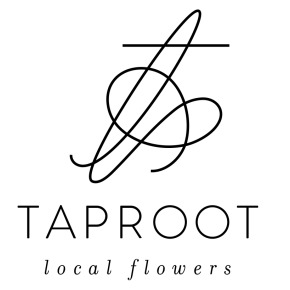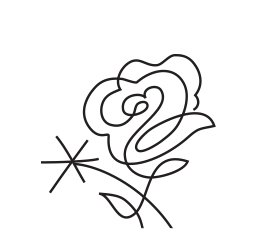My peonies won’t open. What should I do?
Try placing the stems in warm water, and leave your bucket in a warm place.
If you’re in a hurry, swish the heads in a bucket of water. You'll see air bubbles form in the water, and the bloom should slowly open.
My roses won’t open. What do I do?
Remove the guard petals. See those little brown or green petals on the outside of your rose? The ones that look wilted? Peeling these petals off will help the bloom open.
Blow on the petals. (Yes, really.)
Use your fingers to separate the petals.
Use Quick Dip. (See FAQ Part II for more on this.)
If you want to create a "picked from the garden" look, pull the center petals out of roses.
You can also "reflex" roses. Starting with the outermost layer, pull back 3-5 layers of petals. Don't pull the petals off, just back. It'll feel like you're turning each petal inside out. (Try reflexing tulips as well!)
My flowers are stuck together! What now?
Flowers that have clusters of tiny blooms, like chamomile or feverfew, tend to get tangled.
To separate them, flip the flowers upside down and gently shake, tease, and pull the blooms apart.
How do I condition hydrangeas?
Cut the bottom of the stem on an angle. Then, slicing straight into the stem, make another small cut up the length of the stem. The extra cut helps the hydrangea drink more water. You’ll also want to do this with other branches like lilac, cherry, etc.
Hydrangeas are unusual in that their petals can drink water. If they’re looking sad, spray the heads with water or dunk them in a sink or bucket of water for an extra dose of hydration.
Before designing with hydrangeas, recut each stem and dip the bottom 1/2 inch into alum powder. (This isn’t a must, but it’ll help them last longer.)
How do I condition poppies?
Remember: burn or boil.
Cut the stem on an angle. Then: sear the end with a flame or dip it in boiling water.
(A barbecue lighter or an electric kettle can make this a quick and easy task.)
How do I process hellebores?
That electric kettle is going to come in handy again! Cut stems on an angle, dip the ends in boiling water for 30 seconds, then place them in cold water.
How do I process lilies?
Cut on an angle and place in water. Remove the anthers using a tissue. Use pipe cleaners to clean off any pollen that's left behind on the petals.
How should I process daffodils?
Daffodil stems release a sap that’s harmful to other flowers. Before arranging with them, cut the stems on an angle and place in clean water. Leave the daffodils to hydrate for at least six hours before arranging them with other flowers.
Here's the key: every time you cut them, daffodils release sap. You'll need to cut the stems to the height you want them to be in your vase before letting them hydrate for six hours.
…I think my cut flowers moved overnight. Am I imagining things?
Nope! If you think they moved, they probably did. Here are a few fun examples of this:
Tulips are phototropic. They grow and bend towards the light.
Some flowers, like tulips and anemones, continue to grow after they’ve been cut. Keep this in mind when designing with them!
Anemone blooms close at night and/or in the dark. Keep this in mind when using them in a dark, candlelit wedding venue.
Snapdragons bend towards the sky. Thanks to negative gravitropism, their stems are pulled in the opposite direction of gravity. Other gravitropic flowers include bells of Ireland and tulips.
Do I need to use flower food?
No. Clean water and a fresh cut are enough to keep flowers happy. Replace the water in your buckets/vases and recut stems daily.
That said, flower food can help flowers last longer, which is always a good thing when it comes to weddings, events, and single order deliveries.
Try both options, and see which works best for you!
What is Quick Dip?
Quick Dip is a chemical solution that helps flowers hydrate and open quickly. Florists often use it with roses.
To use it, pour a small amount in a shallow vase or bucket. Give stems a fresh cut, then give the ends a brief dip in the liquid. (See what they did there?)
After you’ve dipped, place the flowers in a bucket filled with clean water.
Should I spray my flowers with water?
Nope. Use Crowning Glory or another type of floral sealant instead.
(One exception: hydrangeas. Spraying them with water keeps them happy in warm weather.)
What’s Crowning Glory?
Crowning Glory is a sealant that helps flowers retain moisture. Florists spray it on finished design work. It’s especially helpful for keeping bouquets and boutonnières fresh.
Spray it. Spray liberally. Spray it on everything.
Do I need a floral refrigerator in my studio?
In an ideal world, yes. Storing flowers at the right temperature extends the vase life of your flowers.
Refrigeration systems can be expensive, though. Alternative options include:
— using a CoolBot controller to create a makeshift cooler
— searching Craigslist or restaurant supply stores for used fridges
— skipping the fridge and using a powerful air conditioner to keep your workspace cool
(Make sure that the A/C isn’t blowing directly at the flowers so that delicate petals don’t get damaged.)
Do I need to cut my flowers with a knife?
Nope. Many floral designers prefer to use clippers or scissors.
That said, using a floral knife creates a clean, sharp cut and reduces the risk of smushing stems. This is especially helpful for soft-stemmed flowers like tulips.
Even if you prefer clippers, a floral knife is a useful tool to keep around. Use it to remove thorns, dense foliage, and rough edges from stems.
Anything else I should know?
Keep your knives, clippers, and buckets clean!






